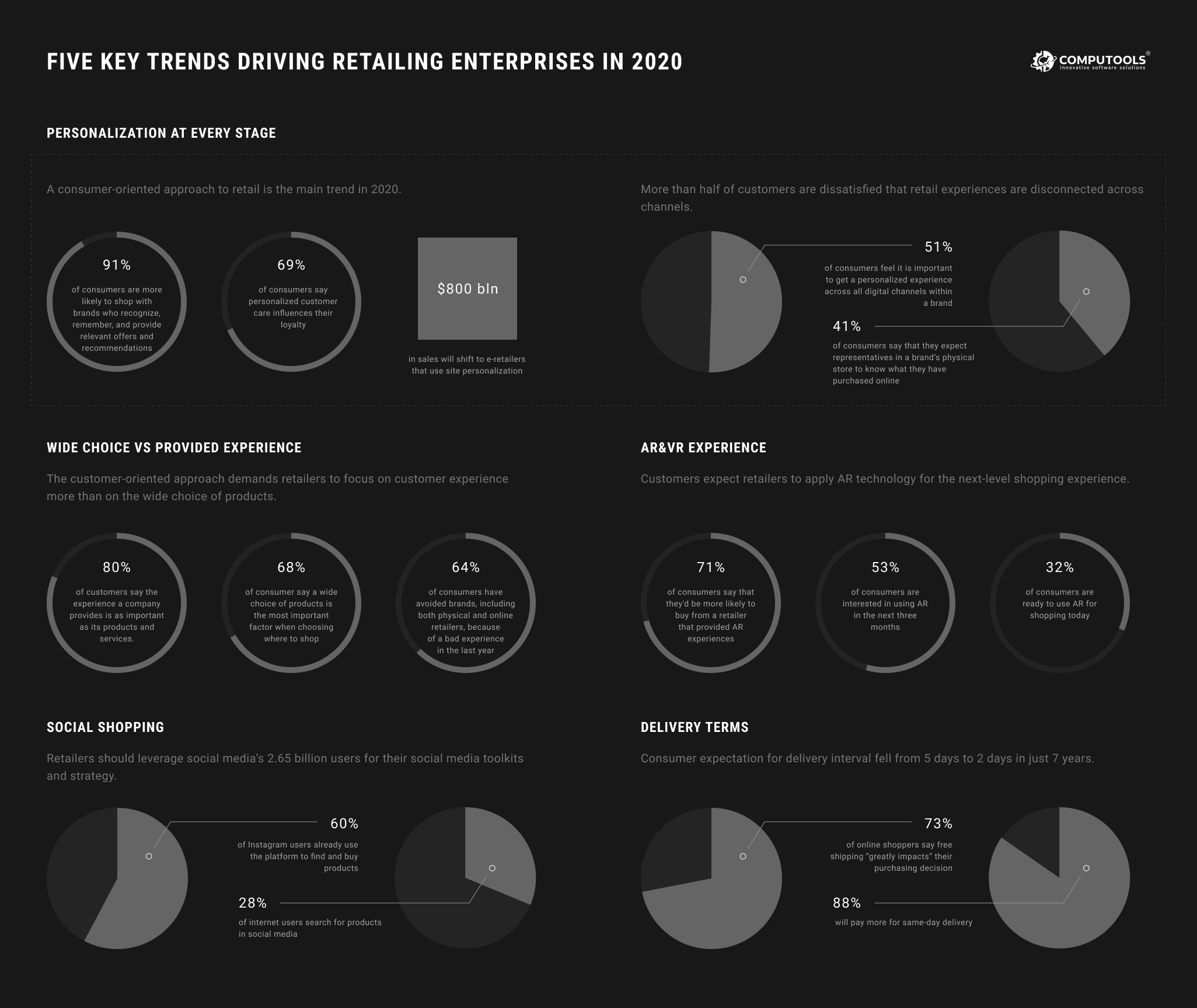- Services
- Approaches
- Industries
- Retail
Get a quicker ROI and stay ahead of the competition
- Finance
Focus on becoming a holistically digital, customer-facing enterprise
- Healthcare
Protect sensitive electronic patient data, manage costs and streamline your workflows
- Consumer Services
Enhance customer engagement experience and boost revenue
- Retail
- Clients
 Computools helps our clients boost their growth and development, improve services, and customer experience
Computools helps our clients boost their growth and development, improve services, and customer experience- #
 Case Studies
Case StudiesTake a look at some of the projects we have recently delivered and find relevant cases for yourself
 Countries
CountriesComputools delivers innovative software solutions around the world
 Solutions Hub
Solutions HubComputools’s reliable turnkey solutions reduce both the time to market and overhead, drive revenue, and foster efficient growth
 Testimonials
TestimonialsWe are only as GOOD as our clients say WE ARE
- COMPANY
 IT Executive Partner In Your Business
IT Executive Partner In Your Business- #
 About Computools
About ComputoolsA global software solutions provider
 Why Computools
Why ComputoolsComputools is a customer-oriented company with an individual approach to each project
 Awards & Recognitions
Awards & RecognitionsComputools has gained expertise over the years to become a top-rated software development company
 Computools’s Values
Computools’s ValuesComputools’s key values and principles form the foundation of the company
 Computools Brand History
Computools Brand HistoryThe history of the brand ‘Computools’ began in 2000
 Executive Management
Executive ManagementComputools CEO and Key Executive Team
- #
- CSR
- Blog
- Get In Touch
#Retail
Five Key Trends Driving Retailing Enterprises in 2020
Discover the experts business trends forecast for retailing enterprises for 2020.

Several factors influence the development and growth of the entire retail industry. However, the key one is the consumer. Most retailing enterprises have already fully adapted their business to a consumer-centric approach. However, studies show that this is no longer enough. Consumers expect retailers to become more convenient with their purchasing experience, new solutions and proposals to simplify processes. The next trends forecast the future of retail technology and offer ways to a successful retail enterprise in the next year, since now they are more urgent than ever.
Augmented Reality Retail
AR is one of the most important trends in retailing. Augmented reality conquered the world of entertainment and continues to move to leadership positions in this field. Meanwhile, in e-commerce and retailing, it is an augmented reality that promises to be the highest expectation from consumers.
Large corporations such as Amazon and Toyota are already offering their potential customers new innovative experiences. AR technology allows experiencing all the benefits of owning a product without buying it. Thus, a customer can find out how the sofa will look in the living room before it is purchased or whether the new dress will fit the selected accessories.
Applying this retail technology enterprises can decrease the number of returns the purchased items from online shoppers up to 25%. Moreover, gaining new experience attracts more consumers. The rapid development of AR technologies makes them more accessible. This means that users will strive for wider use of AR than entertainment. Meanwhile, retailing industry news state that only 23.5% of the retailing enterprises adapted this technology for their stores and only 15% say they plan to do this in the next six months.
Want to increase ROI and reduce operating costs for your business?
CONTACT USFaster Delivery Option
Consumers shop in a few simple clicks on their mobile phone. This was ensured thanks to the transformation of retail technology services. Meanwhile, shopping in a few minutes, consumers no longer agree to wait for delivery for more than one-two days. In some cases, delivery longer than a couple of hours may cause the consumer to refuse the order.
The study shows that free shipping is important for 79% of buyers, while 88% are willing to pay extra for delivery on the same day. Thus, the speed of delivery moves to the first place. Fast delivery from Amazon, food delivery services have shown that reducing delivery time is possible. The logic of the consumer is quite simple: if this company can provide such a service, why my favorite store can’t?
This is why enterprise project management and logistics require transformation and global change. Next year, only those enterprises will succeed that are able to provide their customers with delivery on time. In some cases, the issue is solved by installing new enterprise software that automates the process and speeds up the processing and assembly of orders for customers.
Smart Personalization
Personalization, personalization, personalization. This word, like a mantra, retailing enterprises repeat over the past few years. And this trend will definitely continue in the future, at least for another five to six years for sure.
Studies show that consumers appreciate those companies that value their time and are ready to save it by offering customized search and recommendations, making individual selections and simplifying any operations in the online store. They no longer want to receive a newsletter with all the promotions and discounts, but they will be happy to receive a personalized one, where only their preferences and wishes are taken into account.
The business development strategy should include investments in the implementation of AI and ML in the processes of online retailing. These technologies, mixed with Big Data and IoT, can provide comprehensive information to the consumer, his tastes, habits and behavior in the online store. Using this information, retailers can provide the level of personalization that consumers expect from them today.
A retailing marketing strategy should also be built on analytics and AI findings. The better a company knows its consumer, the better offers it can make for it. The whole secret of smart personalization is the timely use of smart technology.
Social Shopping
While startups and small businesses use social media to interact with their potential consumers, large enterprises can reap much more from this.
The new term – Instashopers – appeared due to the experimental introduction of the opportunity to purchase goods into social media. It is known that about 60% of all Instagrammers use a social network to search and purchase the necessary goods. That is why it is necessary to include development in this direction in the retailing business plan as well.
One of the best enterprise business solutions is a visual search for social media. Let users search by uploading a photo of the dress that they saw on someone on the subway or a photo of a purse that a superstar had on the red carpet. Keywords are not always as effective as product visualization.
Visual search in one click becomes possible thanks to the use of AI. Speech recognition and voice search engines can be perfectly complemented by visuals one to create maximum convenience for consumers. The combination of this technology with social media will take the enterprise to a new level.

More Options for Easy Return
The return of purchased goods is one of the retailing problems that can be solved new technologies. However, while the percentage of returns is sufficiently large, consumers want the options designed for this to be as convenient as possible, because the existing ones no longer meet their requirements.
About 42% of consumers refuse to buy the item if the return policy is not transparent, not clear or the process takes too long. About 70% of consumers refused to return an unsuitable product because the procedure required them additional costs.
Consumers want more convenient and flexible choices, including more in-store returns for online purchases and designated locations to pick up and drop off packages. This is especially true for retailing enterprises, who sell clothes and shoes. The consumer is more likely to buy the product if he sure he can easily return it in case of a mistake with the size.
Another side of product returns is the refund for the purchase. As a rule, the procedure takes more than 3 banking days and 54% of buyers expressed their desire to receive a notification on every stage of refund status.
Smart retailing can take the enterprise to the next level, attract more consumers and significantly increase the company’s revenues. The application of the latest technologies, investment in the implementation of innovative solutions will certainly lead to positive business results.
Computools's Services for Retail Industry
Computools’s experts serve a full range of software development services to retail industry players. With our domain-focused software solutions, you get a quicker ROI and stay ahead of the competition.
Contact Us
Let's talk about your project.
Use the form to drop a line or write us an e-mail: info@computools.com




